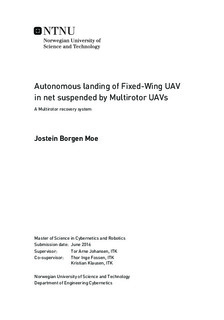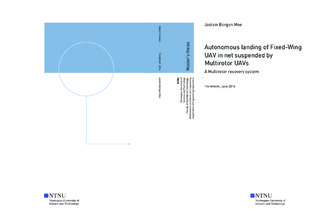| dc.description.abstract | This thesis considers the recovery of a fixed-wing Unmanned Aerial Vehicle (UAV) in
a net suspended by multirotor UAVs. Motivated by marine fixed-wing UAV operations
from ships, where limited landing space and harsh weather conditions often are present, a dynamically controlled net is presented. Traditionally a net is located on the ship-deck, introducing challenges such as heave motion and turbulence near the net. The concept presented in this thesis gives the possibility to move the net away from the ship and optimize the landing trajectory of the fixed-wing UAV according to the current weather conditions. Moreover, the multirotors can carry the net at a certain speed along the desired landing trajectory, hence, reducing the relative velocity and the impact forces of the impact.
A mathematical model of the interconnected multi-body system is presented, emphasizing the impact dynamics. Furthermore, a two-folded preliminary control system architecture is presented, subdivided into the transport and the recovery phase. The transport phase consist of the transportation of a suspended net with multirotors along a desired path, and in the actual recovery phase the net is controlled according to the fixed-wing UAV landing trajectory. The transportation is performed using a Line-Of-Sight (LOS) guidance law in combination with a reference generator. While the recovery phase utilize a modified pure-pursuit guidance law for cross-track control in combination with a desired along-track velocity trajectory, instructed by the approaching fixed-wing UAV. Further different along-track trajectories are proposed with the purpose of controlling the recovery location. The cooperative multirotor control problem are solved using the passivity-based approach given in [Bai et al., 2011] and implemented for cooperative multirotor control in [Røli,
2015]. Furthermore, the controllers are implemented in the open-source DUNE: Uniform
Navigational Environment framework on an embedded system in combination with the
open-source APM:Copter autopilot. The feasibility of the concept are verified by simulations and field experiments. | |

